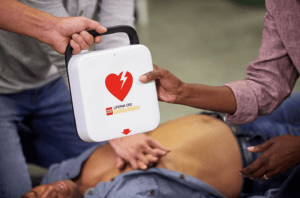AED buying guide: Top 5 considerations for your next device
Garreth | Jul 14 2021 | 2 min read | News
Whether you’re a school principal, safety official, general manager at a fast food franchise or serve in the hospitality industry, adding an automated external defibrillator (AED) is an easy, essential and often overlooked step for your work safety program.
Approximately 350,000 cases of sudden cardiac arrest (SCA) occur outside of the hospital each year in Europe.1 AEDs are lightweight, portable devices designed to help save people experiencing SCA in public and can be used on children, teens and adults. Even minimally trained bystanders can easily operate them by following audible and visual instructions during an emergency.
But not all AEDs are equal— defibrillators come in different shapes, sizes and capabilities. How can you make sure to purchase the right device for your workplace?

5 standards to follow when purchasing an AED
An effective AED program is a critical link in the chain of survival, empowering you to deliver lifesaving intervention even before emergency services arrive.
Stryker offers diverse options to help you choose the right defibrillator for your employees and customers. When purchasing AEDs for your organization, consider these features:
- Ease of use
Choose an AED that uses simple graphics, audible instructions and automated features to help users remain focused. Clear visual and voice prompts guide rescuers through the entire CPR process.
- Readiness
Battery not charged? AED not where it’s supposed to be? These are common issues with devices in public spaces. Purchase an AED that connects to Wi-Fi® and can be set up to alert you to things that may affect device readiness—all automatically.
- Connectivity and technology
Integrated Wi-Fi connectivity can give emergency responders a view into each cardiac arrest event. So even before they arrive, emergency professionals are better prepared and understand the details of the shocks given, see the patient’s ECG and more.
- Affordability
It’s not just the initial cost of the device you need to consider. Think about long-term maintenance, accessory expiration dates and the cost of hiring someone to maintain your fleet.
- Size and durability
Most public spaces need a device with a smaller footprint that accommodates limited space in an office, plane or vehicle. Check for an IP56 rating, which is the industry’s highest level of protection against dust and water in AEDs.